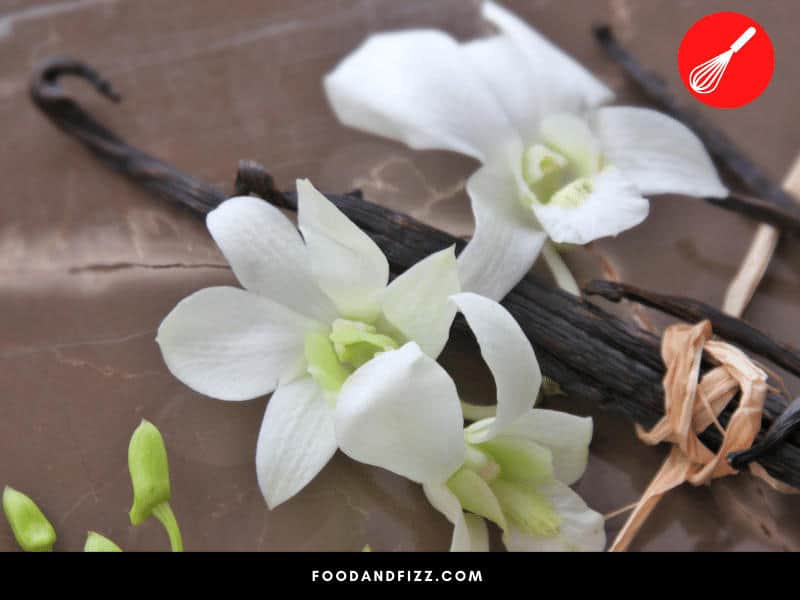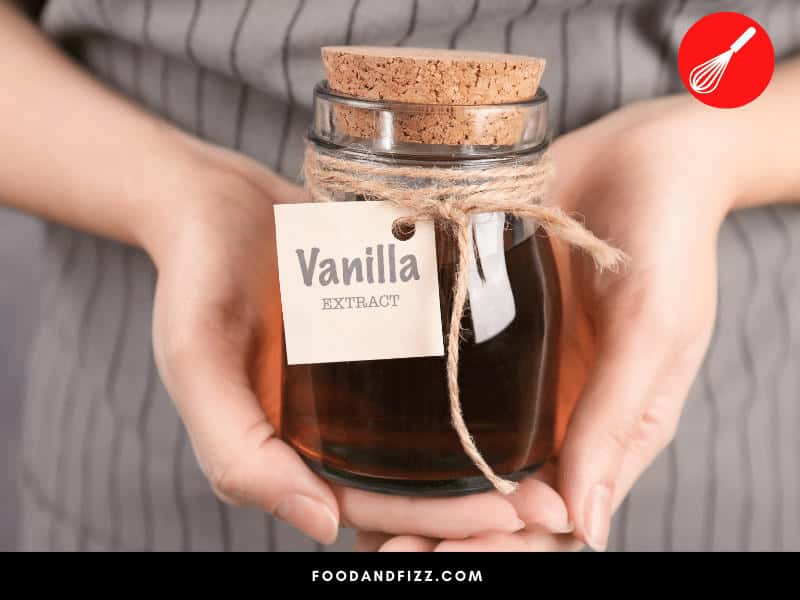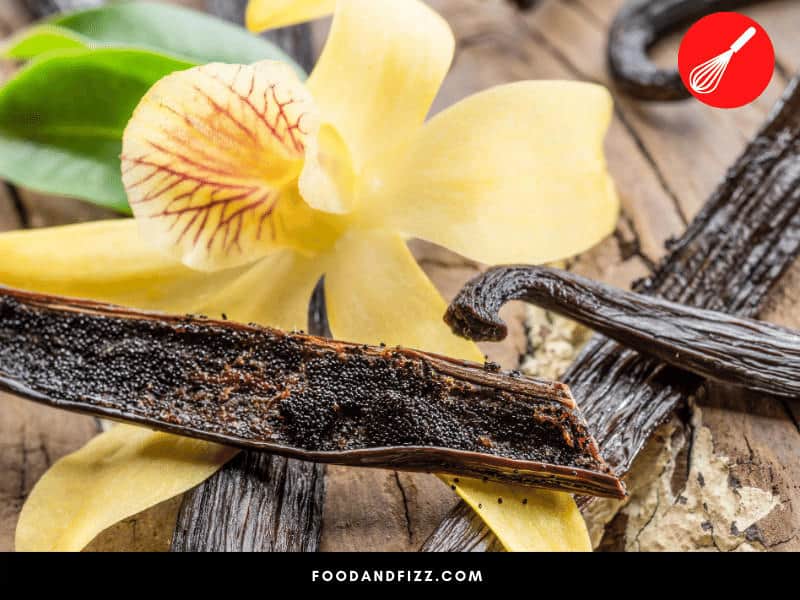1 Tsp Vanilla To Ml
Possibly you lot're an experienced baker looking to weigh your ingredients for a more precise bake. Or peradventure you're an expatriate cook translating from the metric organization to the American measurements.
Or perhaps you've just lost your teaspoon. Whatever the case, you're looking for a conversion from i teaspoon of vanilla extract to grams. Read on to find out the answer to this and other questions.
What is vanilla? Where does it come from? How is it made? Why is it and then expensive? What is ane teaspoon of vanilla in grams? And what's the deal with these different measurement systems anyway?
ane Teaspoon Vanilla in Grams
1 teaspoon vanilla is equivalent to about 4.2 grams. Just go on in listen that while teaspoon is a measure of volume, gram is a measure of weight. In terms of teaspoons to milliliters (a metric measure out of liquid volume), one teaspoon of vanilla would exist equal to about 4.nine milliliters.

What is Vanilla?
Before exploring the intricacies of different measurement systems, permit's consider the ingredient. Vanilla is a vivid and familiar flavor or scent.
It's a sweet spice that appears in all kinds of desserts and beverages, from cookies to Coke. Information technology's also an important ingredient in perfumes and even medicines. But what is vanilla?
Vanilla comes from the blackness pods of a tiny orchid. In fact,vanilla derives from Spanish. The diminutive ofvaina, it means "little pod."
The orchid vine that produces the vanilla pod was get-go cultivated by Meso-American peoples like the Totonacs, and later the Aztecs. Spanish conqueror, Hernan Cortes brought vanilla to the Europeans.
The long, black vanilla pod is also called a bean, and it only appears when the orchid is pollinated. In a naturalistic setting, the orchid merely opens for one days at a select moment of the year, and is pollinated by a particular species of insect, the orchid bee.
However, nigh commercial vanilla extract, called "bourbon vanilla" is made from mitt pollinated beans.

Where Does Vanilla Come From?
Attempts to grow and pollinate vanilla naturally in 19thursday century Europe all failed. To this solar day, about of the world'south vanilla is notwithstanding grown in the tropics, in Madagascar, Indonesia, and United mexican states.
To accommodate the need of commercial product, the orchid is pollinated by mitt using a method invented by a 12-year-old slave child, Edmond Albius from Réunion in 1841, that is however used in contemporary production.
During the twelve-hour window when the flowers open up, vanilla farmers use a splinter of forest to lift the flap between the male and female parts of the flower, allowing it to self-pollinate. The pods brainstorm to grown within a day or ii afterwards, but can have up to six months to mature.
How is Vanilla Made?
Vanilla extract is made by drying and curing vanilla pods and then rinsing them repeatedly in a solution of ethanol and water. The strongest vanilla extract comes from split pods whose seeds are released.
Extraction depends on a precise chemic process using carefully selected pods. Between mitt pollination and extraction, making natural vanilla is a labor-intensive process!
As a effect, vanilla is as well synthesized artificially. Methyl and ethyl vanillin are made from lignin, a natural polymer in wood that is a byproduct from the pulp used in papermaking. Some vanillin used in perfume making is also made from castoreum, the musk produced by beavers.

Why is Vanilla And so Expensive?
Vanilla is the second most expensive spice in the world after saffron. Despite this, vanilla is likewise widely regarded equally the world'south near popular aroma and flavor. The expense of natural vanilla comes from the difficulty of production.
Because natural vanilla only grows in sure places, must be hand-pollinated, must be harvested at the correct time, and must be carefully sorted and cured, it is an incredibly expensive process.
Droughts and other weather bug have long threatened the farming of natural vanilla. Additionally, criminal activity effectually vanilla production increases the cost.
Despite this, most eight tons of vanilla are produced each year. Threescore percent of the world's vanilla all the same comes from Madagascar and Republic of indonesia. An 8 oz. bottle sells for $29, meaning that vanilla costs almost 62 cents per teaspoon!

Why is Vanilla So Popular?
Vanilla remains the world's most popular flavor and aroma, despite its expense. In addition to health benefits from its antioxidant properties, this might be due to some of its other therapeutic effects.
Enquiry has shown that vanilla is calming. Information technology can also provide relief from toothache (though not if consumed in cookies and ice cream!). In fact, vanilla as a substitute sweetener can help adjourn sugar intake.

How Can Vanilla be Measured?
Because it's a rare commodity, vanilla is sold in small quantities. Bottles of vanilla are labeled in fluid ounces (fl oz) and milliliters (ml), the U.s. and U.k. measures of fluid volume.
Fluid volume is typically measured differently from weight (ounces or grams) because a teaspoon of fluid can weigh more than or less than a comparable amount of a dry out ingredient.
For example:
- 1 teaspoon of vanilla = 4.2 grams
- 1 teaspoon of flour = 2.6 grams
- 1 teaspoon of sugar = 4.1 grams
- 1 teaspoon of table common salt = half-dozen grams
Frequently Asked Questions On 1 Teaspoon Vanilla in Grams
Is In that location a Difference Between Natural and Artificial Vanilla?
Some studies revealed that people couldn't tell the deviation between foods made from natural and bogus vanilla. However, in some tests, people preferred the gustation of synthetic vanilla in cookies, and natural vanilla in cakes and ice cream.
What Happens If I Leave Out the Vanilla from a Recipe?
Leaving out vanilla extract from a recipe typically won't alter the chemical structure or touch on the cooking time. But information technology will change the flavor of the result.
Are There Less Expensive Substitutes for Vanilla?
Other extracts similar lemon, lime, coconut, and peppermint are less expensive and can exist substituted for vanilla in some recipes. Imitation vanilla is as well a possibility. Finally, buying vanilla bean paste or powder and steeping it in vodka to brand your own excerpt may also be less expensive.
1 Tsp Vanilla To Ml,
Source: https://foodandfizz.com/1-teaspoon-vanilla-in-grams/
Posted by: ernsttrive1971.blogspot.com


0 Response to "1 Tsp Vanilla To Ml"
Post a Comment